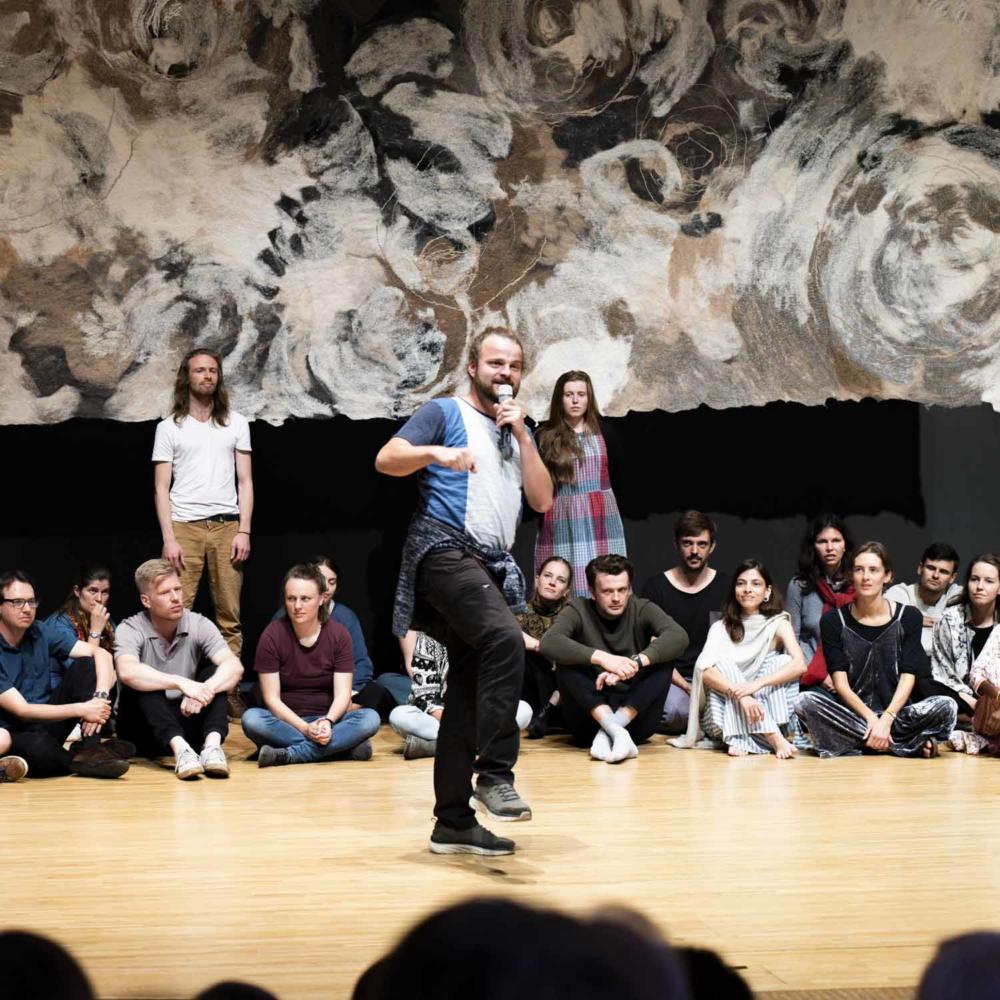A celebration in a time of crisis
The Goetheanum World Conference took place from 27 September to 1 October with lectures, conversations and art (eurythmy, drama, music).
What a celebration it was! Around 950 people from 50 countries came to the Goetheanum’s World Conference which focused on Reshaping a World Movement. One felt connected even without knowing each other. Heart and will forces were tangible, some more subtle, some more visible in concrete projects, and often in the various personalities.
Stocktaking
The centenary of the Anthroposophical Society’s re-founding at the end of this year, an event that is being prepared now, also featured during the World Conference. Similarly to a hundred years ago, we find ourselves again in a dramatic situation with crises and wars around the world. Humanity is dominated by a (now digital) technology that impacts on childhood; Artificial Intelligence lets us ask about the meaning of being human; and the understanding of basic values is disappearing.
And yet, the situation today is different. A hundred years ago anthroposophy was still in the fledgling stage, while we can now look back on the history of its effectiveness, which is ongoing.
We are not standing before the ruins of the burned-down First Goetheanum now but are able to meet and speak to each other in and around the Second Goetheanum. Individual responsibility is required more than ever now for the continuation of the anthroposophical impulse.
This Michael Conference started with a trumpet call from the gallery of the Main Auditorium, during which Claudy Jongstra’s tapestry Guernica de la Ecologìa was lowered onto the stage. The title of this work of art refers to the ecological challenges we are facing today. A number of audience members walked on to the stage one by one and looked at the tapestry before four of them turned to the rest of the audience and briefly spoke about their work.
The audience was then invited to step out onto the terrace and speak with one other person about the questions: What burning question lives in me? What are my concerns in life? What question or intention brought me here? – spending ten minutes on each question.
A celebration needs a festive ambiance. Numerous works of art were scattered in and around the Goetheanum (and are still there now): the tapestry in the Main Auditorium, a relief made of hammered steel by Peter Goehlen in the Reception area, paintings by people with support needs in the Terrace Room as well as sculptures by Ferose and paintings by Stephane Zwahlen (Anthroposophy Worldwide 10/2023) inside the Goetheanum and around the Garden Park. The iron art works are a reflection of our Michaelic age: there is much to do – let’s get started. How this is done is illustrated among other things by a permanent exhibition about Rudolf Steiner, the Anthroposophical Society and the Sections of the School of Spiritual Science.
Abundance of content and initiatives
Nurturing content was provided in the form of contributions on the will, the beat of heart and lungs and Spirit Beholding. Peter Selg spoke of the human will as a phenomenon that has really only been described quite recently. Christine Gruwez and Constanze Kaliks illustrated the beat of heart and lungs making their topic tangible even in their delivery.
Christine Gruwez explored the meaning of ‘movement’ in our relationship with the world, our standing between cosmic heights and earthly depths, our horizontal relationship with each other. She described the awakening of the heart and the emergence of warmth, of centre and periphery, the rhythms of time and how we become contemporaries of a particular time. She continued by referring to different kinds of courage: the courage for the fragment that bears within it future potentiality. The courage to be vulnerable lets us acknowledge that we don’t live in a world permeated by god but in one where we remain connected to the divine due to Michael. And finally, she spoke of the courage to wake up which needed to be complemented by the courage to stay awake.
Constanza Kaliks described how, in the centre of centres, the heart, we are connected with the world-I. We have a relationship with time and the world of emerging deeds. Referring to Paulo Freire, she explained how we each represent our own ‘condition’ which is, however, not determined but allows for new developments.
In a dialogue, Christiane Haid and Wolfgang Tomaschitz explored the realm of Spirit Beholding based on the importance of thinking (see here for an abridged version of their conversation).
The breadth of anthroposophical activities was apparent in many projects and achievements, for instance in the vigour and potential of visions, the importance of individual actions and the vitality as well as mortality of institutions. It was mentioned again and again how anthroposophy can re-enliven cultural traditions by helping people to unlock their (spiritual) content in a new way.
Lastly, the earnestness and creative commitment of the many young people was strongly tangible in their presentation on stage, their filing off the stage at the end mirroring the opening ceremony.
The global character of the conference was noticeable in the choice of both English and German as conference languages and the fact that there was interpretation into Chinese, French, Italian, Portuguese, Russian and Spanish.
First resonance
The conference was so intense that I felt almost hung-over afterwards: a great celebration, brimming over with content … The preparation team is now evaluating the feedback and the many results. A first impression of the comments is that they speak of a great success, gratitude, balance and a Goetheanum of openness. From some I heard the wish for more flexible formats where something can grow between those present.
Any agreements and future plans will be reported on as soon as the evaluation process is complete.

